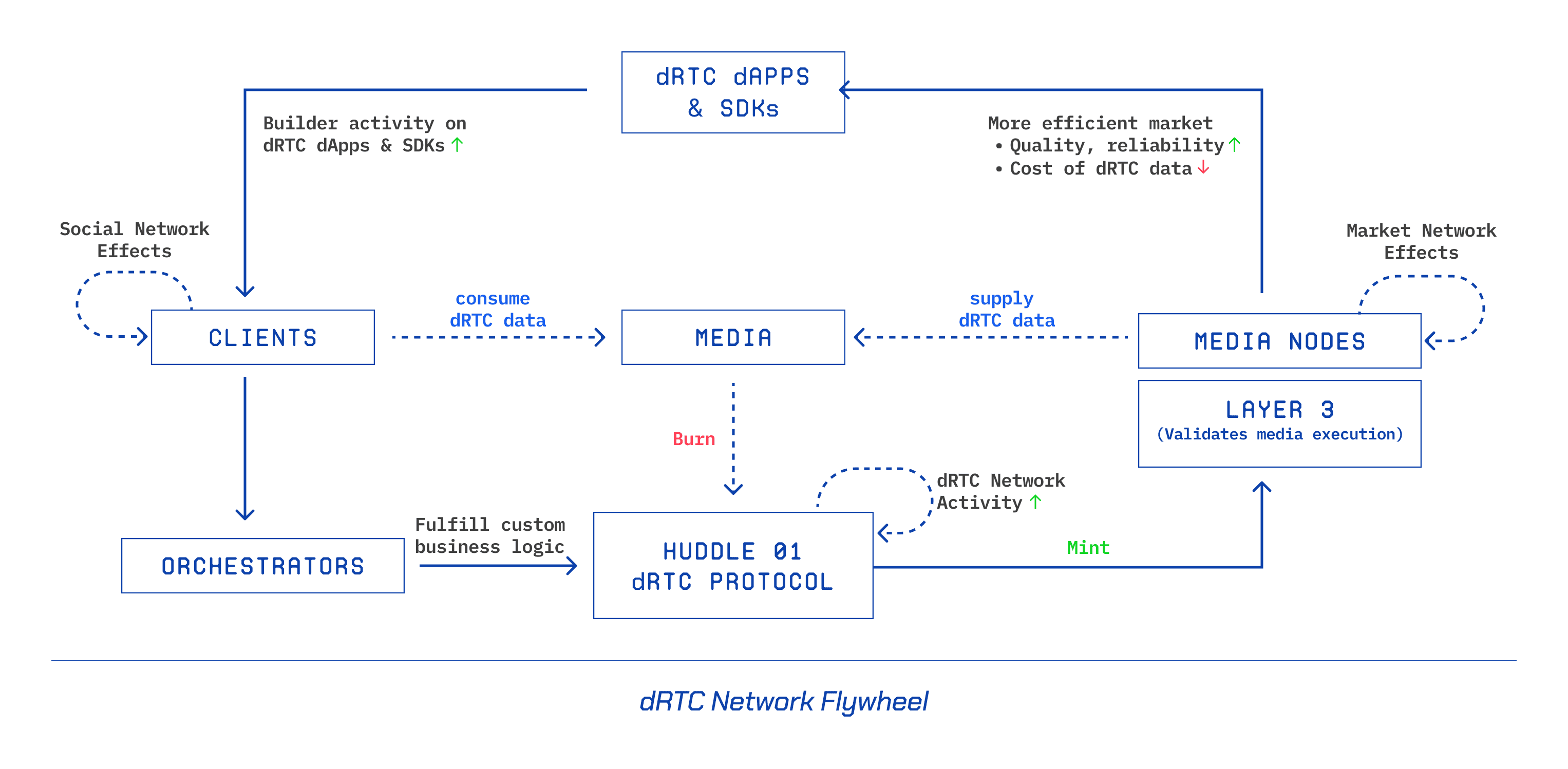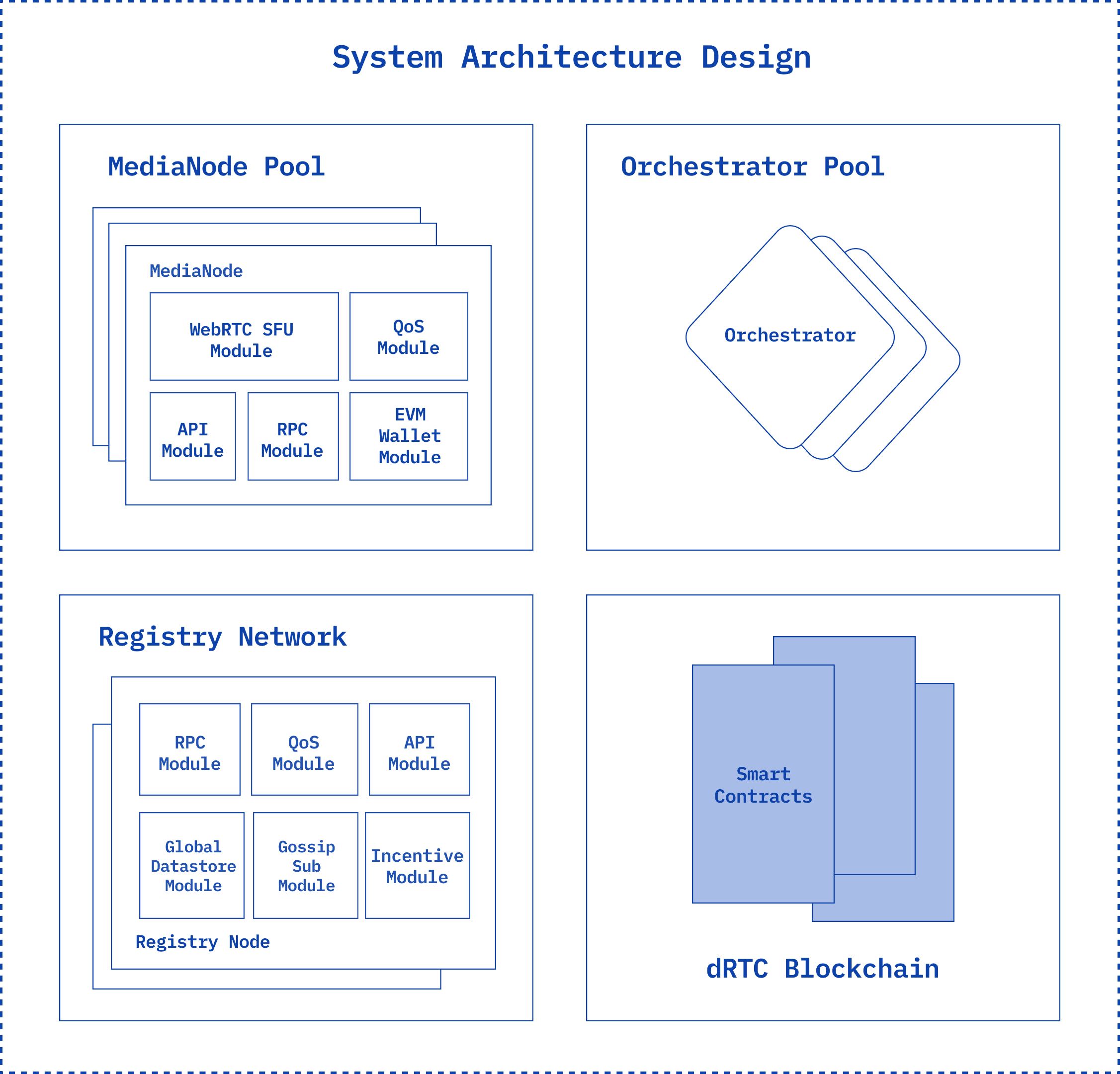Overview
The decentralized real-time communication (dRTC) network is a protocol to democratise synchronous connectivity over cyberspace.
Overview
The decentralized real-time communication (dRTC) network is a protocol to democratise synchronous connectivity over cyberspace.
Overview
The decentralized real-time communication (dRTC) network is a protocol to democratise synchronous connectivity over cyberspace.
Overview
The decentralized real-time communication (dRTC) network is a protocol to democratise synchronous connectivity over cyberspace.
The dRTC network achieves this through a multi-sided prosumer marketplace of real-time data, providing anyone the ability to supply real-time data and earn rewards, or participate in secure, private, and competitively priced meetings, audio spaces, or other real-time connectivity apps via the dRTC network. The multi-sided marketplace comprises of Media Nodes who supply data and Users who consume data.
The dRTC network achieves this through a multi-sided prosumer marketplace of real-time data, providing anyone the ability to supply real-time data and earn rewards, or participate in secure, private, and competitively priced meetings, audio spaces, or other real-time connectivity apps via the dRTC network. The multi-sided marketplace comprises of Media Nodes who supply data and Users who consume data.
The dRTC network achieves this through a multi-sided prosumer marketplace of real-time data, providing anyone the ability to supply real-time data and earn rewards, or participate in secure, private, and competitively priced meetings, audio spaces, or other real-time connectivity apps via the dRTC network. The multi-sided marketplace comprises of Media Nodes who supply data and Users who consume data.
The dRTC network achieves this through a multi-sided prosumer marketplace of real-time data, providing anyone the ability to supply real-time data and earn rewards, or participate in secure, private, and competitively priced meetings, audio spaces, or other real-time connectivity apps via the dRTC network. The multi-sided marketplace comprises of Media Nodes who supply data and Users who consume data.




The architecture comprises four key components: Orchestrators, Registry, Media Nodes, and the dRTC Chain.
The architecture comprises four key components: Orchestrators, Registry, Media Nodes, and the dRTC Chain.
The architecture comprises four key components: Orchestrators, Registry, Media Nodes, and the dRTC Chain.
The architecture comprises four key components: Orchestrators, Registry, Media Nodes, and the dRTC Chain.




Orchestrators
They serve as the control center, optimizing resource allocation, managing application-specific features, and ensuring efficient operation and routing.
Orchestrators
They serve as the control center, optimizing resource allocation, managing application-specific features, and ensuring efficient operation and routing.
Orchestrators
They serve as the control center, optimizing resource allocation, managing application-specific features, and ensuring efficient operation and routing.
Orchestrators
They serve as the control center, optimizing resource allocation, managing application-specific features, and ensuring efficient operation and routing.
Registry
It acts as the system’s directory, enabling components to discover each other while maintaining visibility and observability across the distributed infrastructure.
Registry
It acts as the system’s directory, enabling components to discover each other while maintaining visibility and observability across the distributed infrastructure.
Registry
It acts as the system’s directory, enabling components to discover each other while maintaining visibility and observability across the distributed infrastructure.
Registry
It acts as the system’s directory, enabling components to discover each other while maintaining visibility and observability across the distributed infrastructure.
Media Nodes
They form the backbone of the dRTC network, responsible for processing, routing, and managing audio, video, and data streams. They can also distribute workloads amongst themselves for seamless performance.
Media Nodes
They form the backbone of the dRTC network, responsible for processing, routing, and managing audio, video, and data streams. They can also distribute workloads amongst themselves for seamless performance.
Media Nodes
They form the backbone of the dRTC network, responsible for processing, routing, and managing audio, video, and data streams. They can also distribute workloads amongst themselves for seamless performance.
Media Nodes
They form the backbone of the dRTC network, responsible for processing, routing, and managing audio, video, and data streams. They can also distribute workloads amongst themselves for seamless performance.
dRTC Chain
It operates as a Layer 3 blockchain, hosting the on-chain elements of the dRTC Network. It manages key processes like incentivization, consensus, and verification mechanisms.
dRTC Chain
It operates as a Layer 3 blockchain, hosting the on-chain elements of the dRTC Network. It manages key processes like incentivization, consensus, and verification mechanisms.
dRTC Chain
It operates as a Layer 3 blockchain, hosting the on-chain elements of the dRTC Network. It manages key processes like incentivization, consensus, and verification mechanisms.
dRTC Chain
It operates as a Layer 3 blockchain, hosting the on-chain elements of the dRTC Network. It manages key processes like incentivization, consensus, and verification mechanisms.

